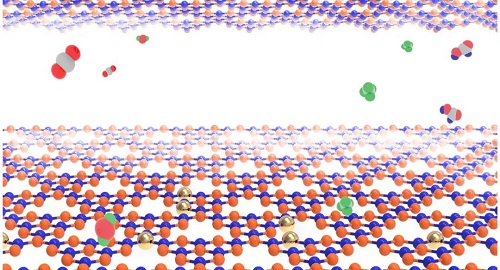
In this work, we prepared ZnGeP2 (ZGP) photocatalyst using single flat temperature zone (SFT) method in a vacuum quartz ampoule. The XRD, SEM, EDS, DRS and XPS were used to characterize the crystal structure, morphology, elemental content, optical absorption and band gap structure of ZGP. The results of photocatalytic hydrogen evolution and apparent quantum efficiency show that ZGP is a promising photocatalyst for hydrogen production both under visible and near-infrared light irradiation. In addition, it is also found that adding the common stabilizer H3PO2 and ultrasonic treatment can efficiently improve the photocatalytic activity and stability of ZGP.
Single-atom photocatalysts, due to their high catalysis activity, selectivity and stability, become a hotspot in the field of photocatalysis. Graphitic carbon nitride (g-C3N4) is known as both a good support for single atoms and a star photocatalyst. Developing g-C3N4-based single-atom photocatalysts exhibits great potential in improving the photocatalytic performance. In this review, we summarize the recent progress in g-C3N4-based single-atom photocatalysts, mainly including preparation strategies, characterizations, and their photocatalytic applications. The significant roles of single atoms and catalysis mechanism in g-C3N4-based single-atom photocatalysts are analyzed. At last, the challenges and perspectives for exploring high-efficient g-C3N4-based single-atom photocatalysts are presented.
Solar energy has promising potential for building sustainable society. Conversion of solar energy into solar fuels plays a crucial role in overcoming the intermittent nature of the renewable energy source. A photoelectrochemical (PEC) cell that employs semiconductor as photoelectrode to split water into hydrogen or fixing carbon dioxide (CO2) into hydrocarbon fuels provides great potential to achieve zero-carbon-emission society. A proper design of these semiconductor photoelectrodes thus directly influences the performance of the PEC cell. In this review, we investigate the strategies that have been put towards the design of efficient photoelectrodes for PEC water splitting and CO2 reduction in recent years and provide some future design directions toward next-generation PEC cells for water splitting and CO2 reduction.
Photoelectrochemical (PEC) water oxidation for sustainable clean energy and fuel production is a potential solution to the demands of organic pollutant removal and growing energy consumption. Development of high performance photoanodes, which is a key component in the system, is one of the central topics in the area. The crystal defect is an old concept but fruiting new understanding with promotive impact to the development of high performance photoanodes. In this review, we elucidated the typical defects involved in the photoanode with the position where they play the roles in the structure and how the properties of photoanode are influenced. In addition, we summarized the feasible protocols to maximize the pros but reduce the cons brought by having defects to the photoanode performance based on recent most prominent research advancements in the field. Finally, we briefly sketched the future perspective with the challenges of this topic when in the scenario of possible developments into practical applications.